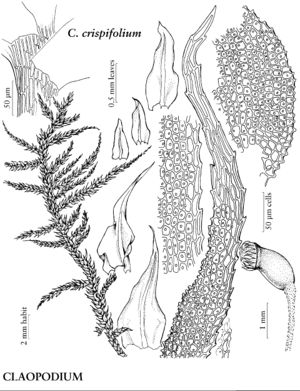Difference between revisions of "Claopodium crispifolium"
Rev. Bryol. 20: 16. 1893.
Illustrated
Basionym: Hypnum crispifolium Hooker Musci Exot. 1: plate 31. 1818
imported>Volume Importer |
imported>Volume Importer |
||
| Line 53: | Line 53: | ||
|publication year=1893 | |publication year=1893 | ||
|special status=Illustrated | |special status=Illustrated | ||
| − | |source xml=https:// | + | |source xml=https://bitbucket.org/aafc-mbb/fna-data-curation/src/2e0870ddd59836b60bcf96646a41e87ea5a5943a/coarse_grained_fna_xml/V28/V28_533.xml |
|genus=Claopodium | |genus=Claopodium | ||
|species=Claopodium crispifolium | |species=Claopodium crispifolium | ||
Latest revision as of 21:36, 5 November 2020
Plants 4–8 cm, in loose mats, green to yellowish, often appearing brownish. Stems ± pinnate, smooth; paraphyllia absent. Leaves ovate, to 3 mm; margins serrate, limbidium present; apex long-acuminate, hair-point present; costa ending before apex, abaxial surface smooth; distal medial laminal cells hexagonal or subquadrate, 8–9 µm, 1-papillose. Seta 1–2 cm, rough. Capsule inclined to almost horizontal, oblong, 1.5–3 mm; operculum long-rostrate. Spores 9–12 µm, smooth.
Habitat: Rotten logs, tree bases, soil over rock
Elevation: low to moderate elevations
Distribution

Alta., B.C., Alaska, Calif., Idaho, Mont., Oreg., Wash., e Asia (Japan, Russian Far East).
Discussion
Selected References
None.
Lower Taxa
None.
